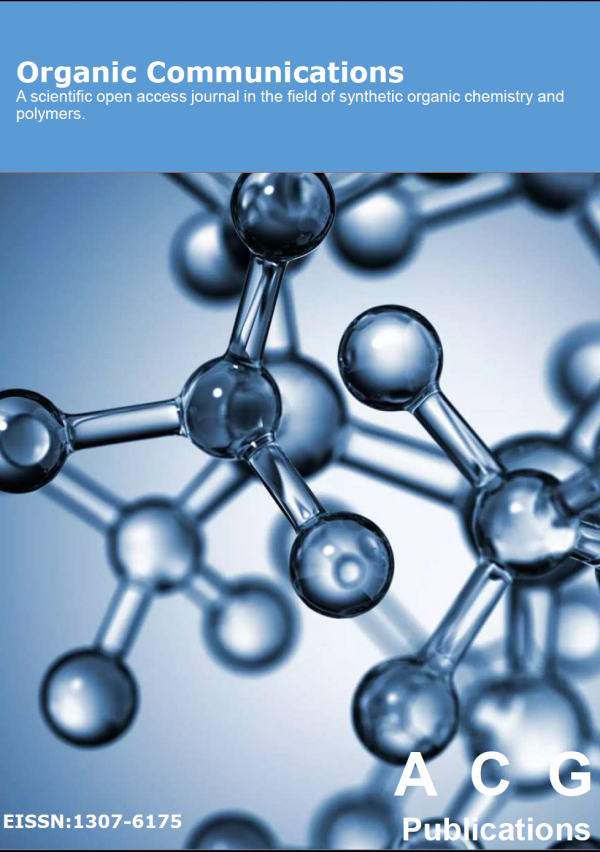Organic Communications
Year: 2018 Volume: 11 Issue:3 July-September
1) Biohydrogels for medical applications: A short review
Hydrogels have been widely used as drug delivery systems for scaffold production (in different soft and hard tissue engineering, including bones), thanks to their biocompatibility and biodegradability. In addition to the possibility of synthesizing a wide range of hydrogels from various natural and synthetic polymers, they are suitable for scaffold production. Moreover, they can have antimicrobial, antitumor and analgesic functions due to their intrinsic properties or through addition of proper biologically active agents. In this article, different types of hydrogels are reviewed alongside their application areas. Different methods are applied for the preparation of hydrogels and their compositions, and are strongly correlated with the morphological and mechanical properties of the synthesized hydrogels, which had a great influence on the performances of the respective scaffolds. The most effective ways to produce the desired scaffolds are mold casting, especially, 3D printing and electrospinning due to the ability to manipulate and control the shape and size of the desired scaffold as well as their microstructure.
DOI http://doi.org/10.25135/acg.oc.49.18.06.108 Keywords Processing routes chemical composition versus medical applications hydrogels. DETAILS PDF OF ARTICLE © 2018 ACG Publications. All rights reserved.2) Synthesis and anticancer (MCF-7, PC-3) activities of new 2-hydroxy-2,2-bis(4-substitutedphenyl)-N'-[(1E)-(3/4- substitutedphenyl)methylene]-acetohydrazides
A series of five –CH3, -NO2, -OCH3 and -Cl substituted 2-hydroxy-2,2-bis(4-phenyl)-N'-[(1E)-(3/4-phenyl)methylene]acetohydrazide (1a-1e) was synthesized by the reaction of 2-hydroxy-2,2-diphenylacetohydrazide with substituted aromatic aldehydes to give intermediate Schiff bases. Structures of the synthesized compounds were characterized using NMR (1D; 1H, 13C/APT and 2D 1H-1H COSY, and NOESY), FT-IR, UV, LC-MS/MS spectral data and elemental analysis. The geometry of compounds 1a-1e were determined to be “E” by NOESY. All the tested compounds showed cytotoxic activity on MCF-7 and PC-3 cell line at highest experimental concentration (100 µM). Compounds 1b (18.24 ± 7.62 µM) and 1e (7.62 ± 1.85 µM) have strong anti-proliferative activity on MCF-7 cell line, while compound 1b (45.81 ± 1.10 µM) has the strongest activity on PC-3 cell line.
DOI http://doi.org/10.25135/acg.oc.47.18.06.107 Keywords 2-Hydroxy-2 2-diphenylacetic acid acetohydrazide derivatives MCF-7 PC-3. DETAILS PDF OF ARTICLE © 2018 ACG Publications. All rights reserved.3) Practical synthesis and electronic study of non-spiro and spiropyrano[2,3-c]pyrazole-3-carboxylate derivatives via uncatalyzed domino one-pot, four-component reactions
A practical and efficient synthesis of non-spiro and spiropyrano[2,3-c]pyrazole-3-carboxylate derivatives was developed. The synthesis was achieved via a domino one-pot, four-component reaction of diethyl oxaloacetate, hydrazine, aldehyde and malanonitrile in refluxing acidic ethanolic solution under non-catalytic system. This method is rapid, simple and provides products in good yields and can be accessed via different classes of carbonyls, malanonitriles and hydrazine derivatives. Mechanistic study envisaged that this domino four-component reaction proceeds via sequential reactions of pyrazolone formation, Michael reaction and Thorpe-Ziegler cyclization reaction. Strong electronic effects of Knoevenagel and pyrozolone product contribute significantly towards successful cyclization of the title compounds.
DOI http://doi.org/10.25135/acg.oc.46.18.05.104 Keywords Pyrano[2 3-c]pyrazole-3-carboxylate diethyloxaloacetate Michael reaction DETAILS PDF OF ARTICLE © 2018 ACG Publications. All rights reserved.4) Photooxygenation of 4-(5-methylfuran-2-yl)aminocyanopyridine derivatives
One pot syntheses of six-, seven-membered cycloalkane and pyrane junctured aminocyanopyridines bearing furan unit were successfully prepared from the ketones, 2-((5-methylfuran-2-yl)methylene) malononitrile, and ammonium acetate. Photooxygenation of 2-(4-aminocyanopyridine) substituted 5-methylfurans gave 1,4-dicarbonyl functionalized aminocyanopyridine derivatives in good yield in one single operation.
DOI http://doi.org/10.25135/acg.oc.50.18.09.881 Keywords 4-Furyl-2-amino-3-cyanopyridines singlet oxygene 4-oxopent-2-enoylnicotinonitrile. DETAILS PDF OF ARTICLE © 2018 ACG Publications. All rights reserved.5) Synthesis of (E)-10-hydroxy-2-decenoic acid ethyl ester via a one-pot tandem oxidation-Wittig process
The synthesis of (E)-10-hydroxy-2-decenoic acid ethyl ester (10H2DA-EE) (3) was achieved via a one-pot, tandem oxidation-Wittig process from commercially available 1,8-octanediol (1), Wittig reagent (Ph3P=CHCO2Et) (2) and activated MnO2. Subsequent hydrolysis with sodium hydroxide gave (E)-10-hydroxy-2-decenoic acid (10H2DA) (4).
DOI http://doi.org/10.25135/acg.oc.48.18.06.106 Keywords One-pot tandem oxidation-Wittig process (E)-10-hydroxy-2-decenoic acid ethyl ester (E)-10-hydroxy-2decenoic DETAILS PDF OF ARTICLE © 2018 ACG Publications. All rights reserved.